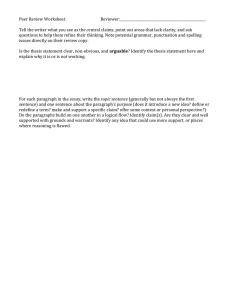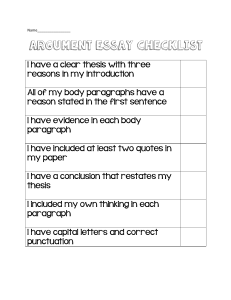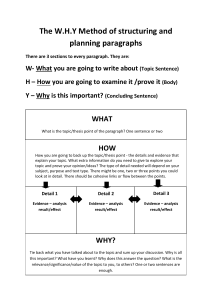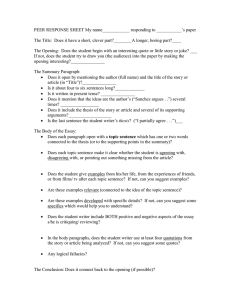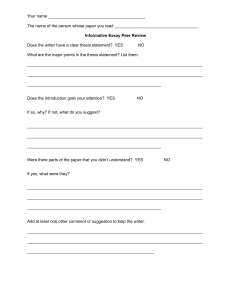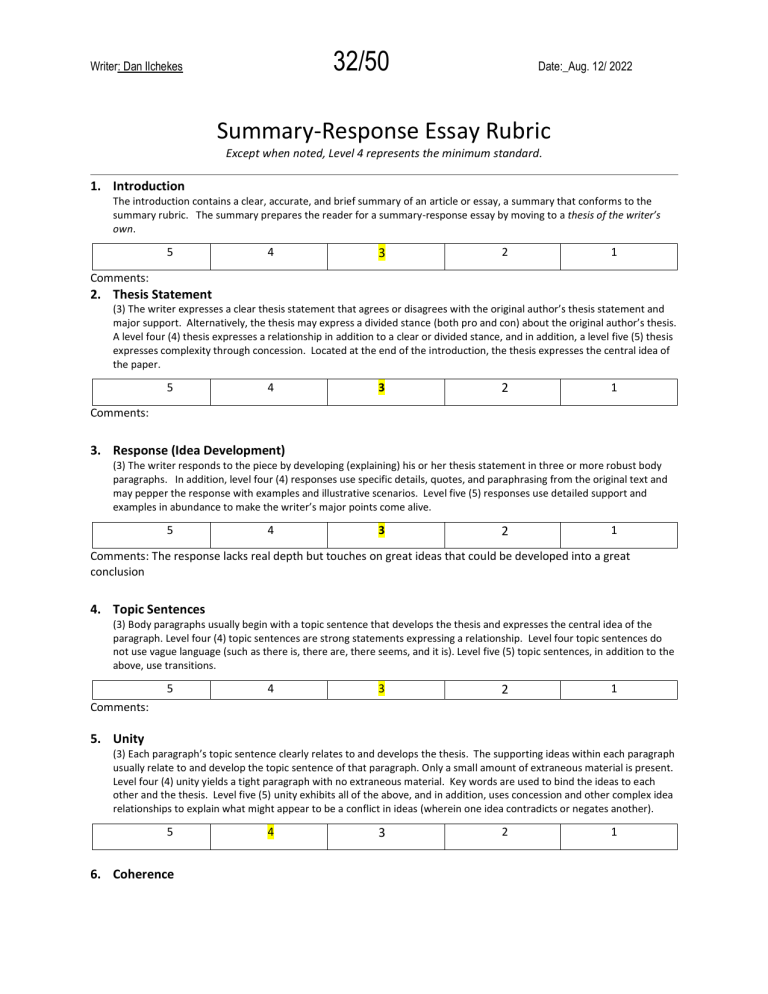
32/50 Writer: Dan Ilchekes Date:_Aug. 12/ 2022 Summary-Response Essay Rubric Except when noted, Level 4 represents the minimum standard. 1. Introduction The introduction contains a clear, accurate, and brief summary of an article or essay, a summary that conforms to the summary rubric. The summary prepares the reader for a summary-response essay by moving to a thesis of the writer’s own. 5 4 3 2 1 Comments: 2. Thesis Statement (3) The writer expresses a clear thesis statement that agrees or disagrees with the original author’s thesis statement and major support. Alternatively, the thesis may express a divided stance (both pro and con) about the original author’s thesis. A level four (4) thesis expresses a relationship in addition to a clear or divided stance, and in addition, a level five (5) thesis expresses complexity through concession. Located at the end of the introduction, the thesis expresses the central idea of the paper. 5 4 3 2 1 Comments: 3. Response (Idea Development) (3) The writer responds to the piece by developing (explaining) his or her thesis statement in three or more robust body paragraphs. In addition, level four (4) responses use specific details, quotes, and paraphrasing from the original text and may pepper the response with examples and illustrative scenarios. Level five (5) responses use detailed support and examples in abundance to make the writer’s major points come alive. 5 4 3 2 1 Comments: The response lacks real depth but touches on great ideas that could be developed into a great conclusion 4. Topic Sentences (3) Body paragraphs usually begin with a topic sentence that develops the thesis and expresses the central idea of the paragraph. Level four (4) topic sentences are strong statements expressing a relationship. Level four topic sentences do not use vague language (such as there is, there are, there seems, and it is). Level five (5) topic sentences, in addition to the above, use transitions. 5 4 3 2 1 Comments: 5. Unity (3) Each paragraph’s topic sentence clearly relates to and develops the thesis. The supporting ideas within each paragraph usually relate to and develop the topic sentence of that paragraph. Only a small amount of extraneous material is present. Level four (4) unity yields a tight paragraph with no extraneous material. Key words are used to bind the ideas to each other and the thesis. Level five (5) unity exhibits all of the above, and in addition, uses concession and other complex idea relationships to explain what might appear to be a conflict in ideas (wherein one idea contradicts or negates another). 5 6. Coherence 4 3 2 1 32/50 Writer: Dan Ilchekes Date:_Aug. 12/ 2022 (3) Each paragraph opens with a transition. The sentences in each paragraph clearly are related to each other by the use of transitions or by reference to the central idea of the paragraph. Level four (4) coherence is characterized by smooth flow from one sentence to the next. Level five (5) coherence exhibits all of the above and in addition achieve smooth flow from one paragraph to the next, including the conclusion. 5 4 3 2 1 Comments: Sentence Structure (3) Sentences are clear and correct. A few choppy sentences may be present. Level four (4) sentences combine the ideas that are related, using coordination (as in FANBOYS), verbal phrases, and appositives when appropriate. Level five (5) sentences present variety in complexity, using conjunctions and conjunctive adverbs to show relationships between ideas. 5 4 3 2 1 Comments: 7. Mechanics, Grammar, and Spelling (3) The essay demonstrates Standard American English. While numerous errors in punctuation, usage, word choice, spelling, agreement, capitalization, and the like are present, they do not interfere seriously with the writer’s ability to communicate his or her ideas. Paraphrases are correctly labeled, but quotations may suffer from incorrect punctuation. Level four (4) essays contain some errors of this kind, and level five (5) essays exhibit few if any errors. 5 4 3 2 1 Comments: 8. Conclusion (3) The essay’s concluding paragraph summarizes the paper and refers back to the thesis statement. Level four (4) essays contain no new information, and level five (5) essays masterfully conclude with a statement bringing the paper full circle. 1 2 3 4 5 Comments:. 9. Organization & Format Notes, freewrites, idea maps (preliminary and advanced), outlines & blueprints, drafts, and peer review notes are attached. The paper is formatted with the student’s name and page number on each page; double-spaced, standard fonts used, margins of 1.0., in APA style with proper title page and page numbering as demonstrated in class and as in the multiple APA paper examples throughout Moodle. 1 2 3 4 5 Comments: This has the beginnings to be a very good summary-response. The APA structure is incorrect and should technically get an automatic “0”. The conclusion lacks deep consideration and the “triangle” formatting taught in class.

